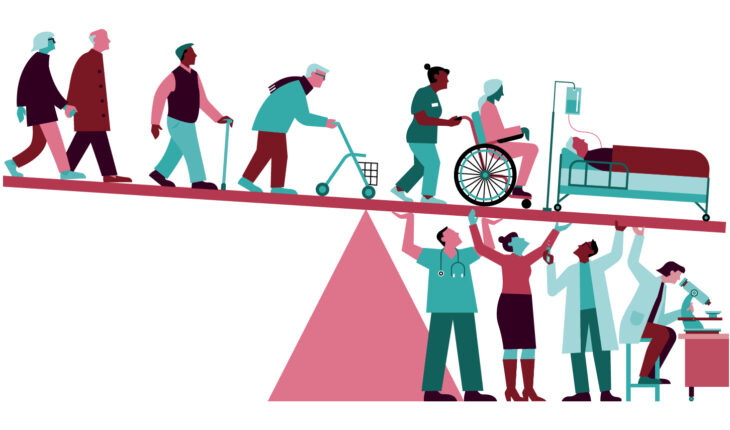
In any country, an increase in the number of elderly people, i.e., people above 65 years of age, leads to a decline in savings, a waning in the labour force, a weakening in the return on investment, and a deterioration in the investment rate. India is a young country compared to the USA and China and will remain young in the coming decades. The elderly population will increase from 5.5% in 2011 to 15.2% by 2050, while in 2050 the elderly population will be 32.6% in China and 23.2% in the US.
Elderly in USA
USA is troubled by long life expectancy, low birth rate, high cost of health care, as there is a rapid increase in public health care expenditure. Because of this, there has been a huge reduction in the number of workers. USA’s dependence on other countries for workers has increased. Industries have also been negatively affected. Cases of loneliness and depression are being seen among children, adolescents, and youth.
Aging population in China
Due to the policy of producing 1 child for a long time, the number of young populations in China has decreased drastically and the number of elderly people has increased radically. Due to the reduction of labour force in the country, the economic and social condition of the country is being negatively affected. In the year 1980, China implemented the one child policy to control the population. This plan was strictly implemented. In this sequence, apart from sacking people from their jobs, women were also forced to have abortions.
Due to this policy, extensive changes are being seen in the economic and social structure of China. Children are becoming victims of despair and depression. Due to psychological reasons, they are not being brought up properly. There is a lack of confidence in children. Children are seen trying to escape from the competition. Having a child has increased the income of the parents. The level of education has also increased. People have started getting more and more degrees. Education has also become expensive in the changed environment.
According to the United Nations Population Department, in the next century, the China’s labour population will be only 548 million. According to an estimate, by the year 2030, there will be a huge gap in the age difference in the population of China. Obviously, the reduction in the labour force will have a negative impact on the country’s infrastructure, which is the driver of development. Lack of labour force will adversely affect road, electricity, health, education, industry, manufacturing etc.
Effect of aging in India
In the states of India, a complex situation can be created regarding the elderly population. The data suggests that some states, which include most of the states in South India, may see an unprecedented increase in the elderly population. According to an estimate, India’s population may reach 178 crores by the year 2050, while according to the World Bank, by the year 2050, India’s population will be 173 crores, in which 27 crores population may be of the elderly. State-wise, this number looks alarming. By the year 2050, in 4 southern states like Andhra Pradesh, Kerala, Karnataka and Tamil Nadu, one-fifth of the total population will be of elderly population, whereas, in the states of Maharashtra, West Bengal, and Odisha, a large population is elderly. There will be a continuous exodus of labour from Northeast India in the coming decades, as has been happening in these states for the past decade. In the states of Uttar Pradesh, Rajasthan, Assam, Bihar, Haryana etc., the number of youth population will be more in the year 2050, due to which the migration of youth from these states to the southern states will continue.
Such changes may also increase the pressure on the infrastructure of the southern states. To avoid a “Demographic Crisis”, Andhra Pradesh has started encouraging people to have more children. State-wise per capita income data shows that the southern states are richer than the northern states and there is a wide gap in the income of the two regions. For example, the difference in per capita income between Karnataka and Bihar is Rs.1.1 lakh, while the difference between Karnataka and the national average is about Rs.57,000. By the year 2050, the elderly population in southern states will increase, widening the income distribution gap even further.
Conclusion
It can be said that the demographic change in India is pointing towards a big crisis, which needs to be acted upon in time. In totality, even though its effect is not visible in the economic and social perspective, but its far-reaching effect cannot be ruled out, because as the age of the people increases, there is an increase in savings, but in the older age, there is an increase in health expenditure. Reduction in savings has a negative impact on the domestic products of the states.
An analysis of demographic data shows that by the year 2050, Andhra Pradesh will have the highest percentage of elderly population in the country at 30.1%. Kerala with 25.0%, Karnataka 24.6%, Tamil Nadu 20.8%, Himachal Pradesh 17.9% etc., while Haryana will have the lowest population of elderly at 9.8% in the year 2050. However, the states of Bihar, Uttar Pradesh, Assam, Chhattisgarh, Rajasthan, Jharkhand, Madhya Pradesh, Gujarat, Uttaranchal etc. will be in a better position in the year 2050 in relation to the youth population.
Keeping in view the changing demographic trend, the states of the country need to formulate policies and implement them. States having young population should set up labour-intensive industries, so that the young labour force can be used properly, while states having large population of elderly people should go ahead with the policy of increasing the retirement age. However, India’s social and economic policy is different from that of China and USA. Nevertheless, in our country, a policy can be made in favour of the common people. Presently, politicians in the country are working with full vigour even at the age of 70 to 80 years. If the policy is made according to the trend of demographic change in the states, then some better results can be expected on this front.
Satish Singh–The Author is Ahmedabad based Senior Columnist. Views are personal.
Mobile Number-8294586892





